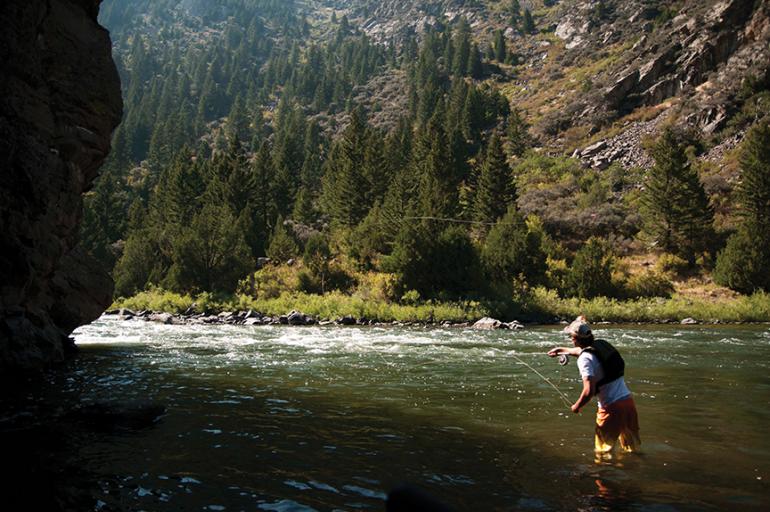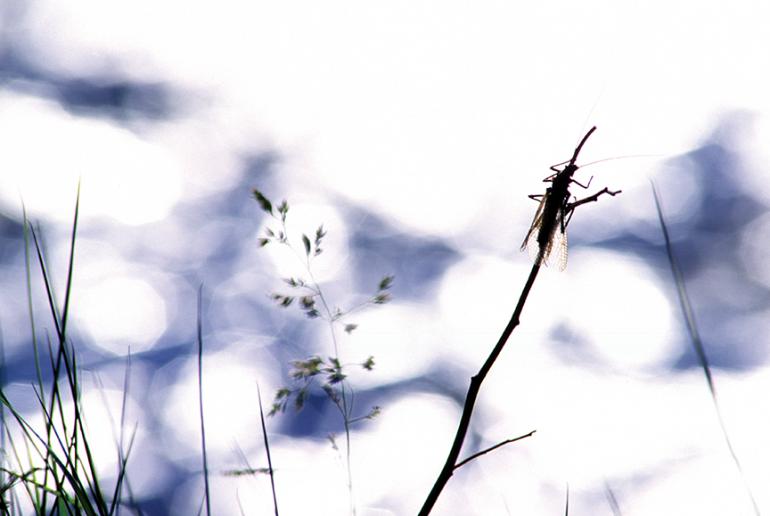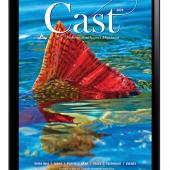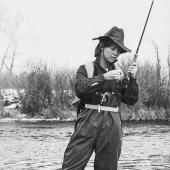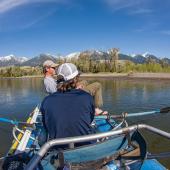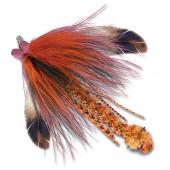One for Luck
You walk then, pulling your Sage four-weight together and stringing line as you walk. Without being at the creek, or seeing what is going on down on the water, you twist a knot through a bead-head pheasant tail nymph—a safe bet and familiar start.
You see the first fisherman where the trail hits the stream. You make no move to find a place to fish. You walk. Through sage and blue flag, past penstemon thick with bud and promise. Grasshoppers launch into the sage, small ones, nothing big enough or abundant enough for you to stop and tie on a hopper pattern instead of the bead-head. You see another group of fishermen spread out just wide enough so they can shout fishing success back and forth and still you walk, nodding at them, passing a word or two of fishing report back and forth and you move on. They are dressed in waders and fly vests, not prepared for a longer walk into the canyon. That’s two groups. Five cars. There should be more ahead and you go on, drinking from the water bottle in your pack, walking fast.
The sage scrapes against your bare legs and a rock works its way into your tennis shoes, but you press on. You will wade wet, braving the melt of early summer snow. Waders would be nice but you need the mobility of shorts and tennis shoes and will sacrifice cold legs and numb toes for a fast walk down a twisted canyon.
You pass a lone fisherman and you stand and watch for a while. It is a young guy wearing a straw hat, and he casts beautifully and mends his line on the water. You tear yourself away from the scene and move on, over clumps of cactus and sage, through alder and willow thickets, past lichened granite.
The canyon drops and you see another fisherman, then another. That, you think, could be the last of them and you walk farther. Your fly line is still dry. The big fish and the better fishing are farther down.
Finally the stream. It runs to your thighs and is the color of black tea baked in a hot sun. It is not the color you were hoping for, a little dingier, more sullen, than a good fly-fishing stream should be. But you have walked all this way and you work the fly out of the keeper and lay out a long stream of line in a perfect, coordinated cast, thinking, Not bad for the first cast of the summer. The fly bumps along, ticking the bottom, rolling with the current. You cast again. And again. Again.
No fish takes the bead-head, but you don’t quit. You are alone and you know that these fish have not seen too many fishermen. You are too far down the canyon, have worked too hard for this and you will not retreat in your quest. Finally, though, you reel in and take up the wet line in your left hand, feeling the water stream off your fingers, checking the leader for wind knots—you’ve tied two—and looking over the nymph. A fluttering by your ear makes you change your mind about the fly on the end of your line. It is a big bug, a salmon fly, and somehow, it flies. It looks too big to fly, prehistoric somehow, awkward. Dinosaurs shouldn’t fly but pterodactyls did and this one does too. It is no surprise that the names of both creatures start with pt: pterodactyl and pteronarcys. It’s as long as your little finger and you watch it helicopter up over the willows and disappear. For a while, you watch the hole in the sky where it was and you wonder if perhaps you imagined that huge insect, if you dreamed it up in your fish-crazed mind. Then another one comes in low, barely skimming over the water, and you stand open-mouthed, watching it. You think you’ll hear a huge splash, a gulp and a hole will be left in the water where a brown as long as your forearm rose and sucked the bug into its maw. But nothing happens and this salmon fly, too, flies off to breed.
Hurriedly, you spin the knot around a big fat orange Stimulator. It’s the biggest thing in your box, not as long as your pinkie finger, but long enough. You hope. You dress it with floatant and make a few hesitant false-casts and lay it on the stream. It bobs well, and you can even see it when you cast it into the sun and the light slivers off into the sky and your eye. Still, you can see it and you lean forward into the drift, pointing the rod tip and the fly, waiting, waiting.
You cast again. Nothing. There is nothing going on. The bugs are out now, not thick. Not a hatch, per se, but still the bugs are out and surely something should be hammering the fly. It’s really not that far off from the real thing.
You fish for an hour, then eat lunch. It’s a sandwich of roasted garlic, left-over elk steak from last night’s grill and thick sharp Vermont cheese. It is your attempt to eat right and you lie back and listen to a vireo trilling from an alder and chew on the soggy bagel sandwich. You watch the big stones floating in the wind up and down the stream and still, nothing is doing. Nothing on the surface, nothing below. You roll up onto an elbow and you debate the next move and finally rise and cast. It’s a beautiful cast and the fly rides high on riffle and wave and still nothing. You decide to change and casually, lazily, the fly trails off into the current and hangs there at the end of your line, bouncing in its own wake, the current pulling on your rod. You thumb through your fly box, and find a San Juan worm. Mighty close to bait, but what the hell, and as you lift your rod to grab the leader so you can clip off the Stimulator, you notice a weight at the end of the line and you set the hook. It’s a brown and it takes to the air, and dances on its tail and then runs into deep water and you hold the rod high and stuff the fly box into your shirt pocket with the other hand and you fight him for a while, perhaps a minute, maybe five. And the shallow back eddy is there and you gently remove the hook and he flicks back out into deep current. A big, nice, fat brown.
“It’s a bit like life, isn’t it?” you say aloud. Work hard getting there, go one step farther than most, pause occasionally to admire the work of a peer, and then work at your task all day long to no avail.


